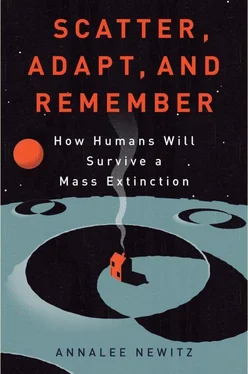Worse than the initial wave of epidemics was the fact that American groups had no time to recover from their losses. In England, after the Black Death hit, common people were able to continue in the same jobs and homes they’d had before the pestilence. In fact, as the Peasants’ Revolt makes clear, many were able to demand a better way of life because their labor had become more valuable. But in the Americas, new colonial governments and militias used their power to force plague-weakened groups off their lands, or tempted them into trading their livelihoods away for guns and horses. Biological catastrophe was followed by political catastrophe, which led to the kinds of displacement and poverty that can correlate with high death tolls in epidemics. In many regions, missionaries would push native groups to live in missions where men and women were separated, thus ensuring that the population couldn’t rebuild itself by forming new families and having children.
David S. Jones, a Harvard historian and medical doctor, sums up the issues succinctly in his influential paper “Virgin Soils Revisited”:
Any factor that causes mental or physical stress—displacement, warfare, drought, destruction of crops, soil depletion, overwork, slavery, malnutrition, social and economic chaos—can increase susceptibility to disease. These same social and environmental factors also decrease fertility, preventing a population from replacing its losses.
American epidemics were likely triggered by the same factors as the European ones. The main difference was that the rapid advance of colonial intrusions in the Americas prevented populations from recovering before they were hit with another wave of disease.
What the plagues of the past 700 years reveal is that human mass societies can magnify the effects of threats that come from the environment, like disease. As our cultures grow, so, too, do our vulnerabilities to extinction. There are many failure modes when we try to adapt to our new circumstances as creatures who can no longer wander off to found a new community the way our ancestors did. Rigid class divisions and warfare are two such failure modes, and they are often accompanied by pandemics. As the University of Colorado history professor Susan Kent explains in her recent book about the 1918–19 flu epidemic—the worst in human history since Chaucer’s time—this pandemic virus quickly became more virulent because it spread with the movements of soldiers during World War I. As waves of soldiers succumbed to the flu, new ones came to replace the dying. The virus always had fresh new hosts, who were generally being shipped across the globe to new locations where the flu would take hold. Like the Black Death, the 1918–19 pandemic led to reforms in health care and indirectly sparked several colonial rebellions reminiscent of the Peasants’ Revolt.
We can excavate a grim survivor’s lesson from the piles of bones these pandemics left behind. We are currently struggling to adapt to life in a global society, where the dangers of culture-saturated, densely populated cities have replaced the dangers of the wilderness. And we are adapting. With each plague, there arise social movements that inch us closer to economic equality and clarify what’s required to take a scientific approach to public health.
The lingering social effects of the American plagues are nevertheless a reminder that there’s a lot of work that remains to be done. Those waves of colonial-era pandemics helped usher in an era of economic inequality between colonizers and the colonized, undermining civilizations that had thrived for thousands of years. Anishinaabe author and University of New Mexico American Studies professor Gerald Vizenor argues that native cultures and peoples have survived throughout the Americas, though often in dramatically altered form. They’ve done it by maintaining communities, passing on stories to younger generations, and fighting for political sovereignty when they could.
Vizenor coined the term “survivance” to describe the practices of natives today who are connected to their cultural traditions, but also living them dynamically, reshaping them to suit life in a world forever changed by colonial contact. The difference between survival and survivance is the difference between maintaining existence at a subsistence level and leading a life that is freely chosen. As we contemplate the ways humanity will endure, it’s worth keeping the idea of survivance in mind. One of the best things about H. sapiens is that we are more than the sum of our biological parts. We are minds, cultures, and civilizations. I don’t mean to say that people can live on ideals alone: That’s obviously stupid. But when we aspire to survive disaster, we are perhaps without realizing it aspiring to survive as independent beings. We aren’t aiming for a form of survival that looks like slavery or worse.
The European and American plagues changed the world, both environmentally and economically. They also revealed a basic truth: Survival is cultural as well as biological. To live, we need food and shelter. To live autonomously, we must remember who we are and where we came from. As we’ll see in the next chapter, this is especially the case when it comes to another one of the greatest threats to human survival: famine. Often, the regions most deeply stricken by hunger are also places where people have been deprived of social and economic power.
9. THE HUNGRY GENERATIONS
IT’S BEEN CALLED Black ’47, the Great Irish Famine, and the Potato Famine. From 1845 to 1850, Ireland was hit with one of the most brutal famines of the nineteenth century after several annual harvests of potatoes were ruined by blight. Two million people died, and the harshness of the experience sent at least a million more to seek new homes in the United States and England. Though the Irish population was 8 million in 1841, today it hovers at roughly half of that. The country still, over 160 years later, has not recovered from the aftereffects of a disaster that changed not just Ireland but the entire way we conceive of famine.
Famines have been recorded in historical documents and religious books for almost as long as humans have been writing, and yet they are still among the most poorly understood causes of mass death among humans. The University College Dublin economist Cormac Ó Gráda has spent most of his career studying famine, and admitted to me that it’s very difficult to say how many people die of starvation when “most people in famine die of diseases.” In fact, he added, malnutrition is a bigger killer than generally believed because it leads to the scenarios we explored in the previous chapter, where people are more vulnerable to epidemic disease. It’s only in the last few centuries that we find reliable, complete records of famine that scholars like Ó Gráda can use to piece together the events that lead to masses of people dying from want of the most basic resource: food.
The Potato That Starves Us
Before the events of Black ’47, the dominant theory of famine came from the eighteenth-century demographer Thomas Malthus, who believed that epidemics and famines were natural “checks” on human populations to keep them in balance with resources available. From the Malthusian perspective, famines should come on a regular basis, especially when a population is outstripping its ability to subsist in a particular area. When the Irish Potato Famine first began to unfold, however, journalists covering the events realized that the Malthusian explanation wasn’t adequate. This famine had its roots in politics. In the decades leading up to Black ’47, industrialization had completely reshaped the Irish landscape. Lands that were once dotted with small farms devoted to a variety of crops were taken over by landlords who converted these farms to pastureland—there, they raised animals for export. Seeking a high-yield crop that could feed their families, peasants on the land that remained available for farming switched from grain crops to potatoes. Many of these peasants were working entirely for “conacres,” or the right to grow their own subsistence food on a landlord’s property. They were living hand-to-mouth, on potatoes, and had no cash to use if their crop failed. When the blight struck, the Irish poor lost both food and money at once. Even at the time it seemed likely that the famine, rather than being a natural “check” on the island’s growing population, was the result of political and economic disaster (itself partly the result of Ireland’s colonial relationship with Britain).
Читать дальше






![Аннали Ньюиц - Автономность [litres]](/books/424681/annali-nyuic-avtonomnost-litres-thumb.webp)





